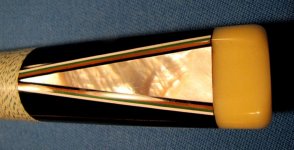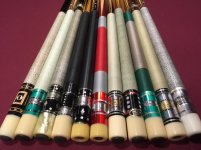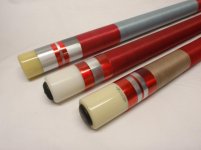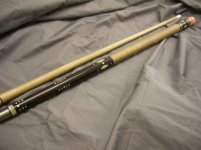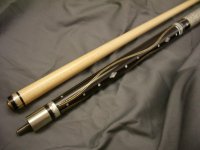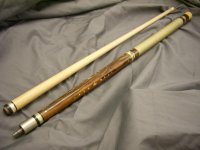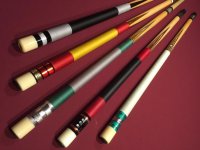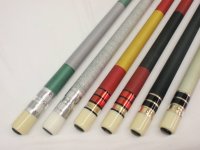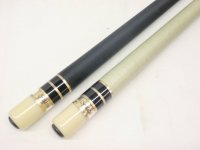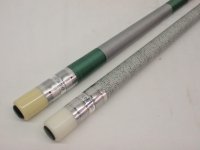You are using an out of date browser. It may not display this or other websites correctly.
You should upgrade or use an alternative browser.
You should upgrade or use an alternative browser.
Show your palmers
- Thread starter rdwell
- Start date
Second Catalog
The Second Catalog -
My initial interest in Palmer cues lay in the second catalog cues. My first Palmer cues were As and Bs and thus my interest lay in those and the other cues in that catalog.
In the attached picture are an A, B, H, I, J, 20 (3rd Catalog) and a few Model B stragglers.
Where ARE all of the Model H cues?
The Second Catalog -
My initial interest in Palmer cues lay in the second catalog cues. My first Palmer cues were As and Bs and thus my interest lay in those and the other cues in that catalog.
In the attached picture are an A, B, H, I, J, 20 (3rd Catalog) and a few Model B stragglers.
Where ARE all of the Model H cues?
Attachments
The Second Catalog -
My initial interest in Palmer cues lay in the second catalog cues. My first Palmer cues were As and Bs and thus my interest lay in those and the other cues in that catalog.
In the attached picture are an A, B, H, I, J, 20 (3rd Catalog) and a few Model B stragglers.
Where ARE all of the Model H cues?
is the butt cap of the 3rd cue from the left not round??
is the butt cap of the 3rd cue from the left not round??
Correct. That is a Model H which featured a wedge butt design very similar to the Model 2 from the First Catalog in the attached picture.
Attachments
Correct. That is a Model H which featured a wedge butt design very similar to the Model 2 from the First Catalog in the attached picture.
wow thanks for sharing that
i didnt know cues were made that way
is it correct to assume that the grip part is round??
wow thanks for sharing that
i didnt know cues were made that way
is it correct to assume that the grip part is round??
Yes. the handle was round. This was a design derived from early billiard cues called a mace. Using a mace the ball was hit using the flat end of the stick. Eventually the other end of the cue was used and the flat butt or wedge was reduced to a design feature. Early Brunswick cues such as the 26 1/2 included this feature as well.
Group Shot
left to right
Custom Palmer - Sister cue to the Jack Colavita cue
Second Catalog Model G
Third Catalog Model 20 "Franklyn"
Second Catalog Model J "Ron Engel"
First Catalog Model 5
First Catalog Model 8
Second Catalog Model D - "Hutch" w/Cocobolo Prongs
Second Catalog Model F - Titlist with original Oval Label
Second Catalog Model E - "John Thornton" 100% original
First Catalog Model 11 - "John Jenkins" 100% Original
Second Catalog Model G
left to right
Custom Palmer - Sister cue to the Jack Colavita cue
Second Catalog Model G
Third Catalog Model 20 "Franklyn"
Second Catalog Model J "Ron Engel"
First Catalog Model 5
First Catalog Model 8
Second Catalog Model D - "Hutch" w/Cocobolo Prongs
Second Catalog Model F - Titlist with original Oval Label
Second Catalog Model E - "John Thornton" 100% original
First Catalog Model 11 - "John Jenkins" 100% Original
Second Catalog Model G
Attachments
Always enjoy looking at your collection of Palmers, thanks for showing them.
I was a frequent visitor in Elizabeth, learned a lot from Margo. The first Palmer I played with was Petes cue at his pool room, The Golden Que.
I was a frequent visitor in Elizabeth, learned a lot from Margo. The first Palmer I played with was Petes cue at his pool room, The Golden Que.
Here's a collection of custom made joint protectors for some of my Palmer cues.
Those caps are fantastic.
1 - a - 4
1 - A - 4
A model that was offered throughout Palmer's Pre - 1st - 2nd - 3rd Catalogs. Shown here are a 1st Catalog Model 1, a 2nd Catalog Model A, and a 3rd Catalog Model 4, obviously all in red.
The 1st Catalog Model 1 is a refinished one owner cue from New Jersey. The 2nd Catalog Model A was found at a California flea market for $25, sold to a buyer in Indianapolis, and purchased by me with the help of Roy Malott and Paul F. Drexler, the 3rd Catalog Model 4 is all original and also from Jersey.
Not many models were continually produced by Palmer and this was the only one in that group lacking a window and foil to be offered in each of the first 4 catalogs.
I have never seen a Model E from the pre-catalog but I am sure they exist.
All of these cues are bar cue conversions or made from non-veneered 4-point blanks supplied by Katz in later years. It is said that many of the cues from the early catalogs were made from house cues already 10 and 20 years old at the time of manufacture.
These sold for $35-$50 new. Not expensive but not cheap. Probably the equivalent of a $150-$200 cue in today's market.
1 - A - 4
A model that was offered throughout Palmer's Pre - 1st - 2nd - 3rd Catalogs. Shown here are a 1st Catalog Model 1, a 2nd Catalog Model A, and a 3rd Catalog Model 4, obviously all in red.
The 1st Catalog Model 1 is a refinished one owner cue from New Jersey. The 2nd Catalog Model A was found at a California flea market for $25, sold to a buyer in Indianapolis, and purchased by me with the help of Roy Malott and Paul F. Drexler, the 3rd Catalog Model 4 is all original and also from Jersey.
Not many models were continually produced by Palmer and this was the only one in that group lacking a window and foil to be offered in each of the first 4 catalogs.
I have never seen a Model E from the pre-catalog but I am sure they exist.
All of these cues are bar cue conversions or made from non-veneered 4-point blanks supplied by Katz in later years. It is said that many of the cues from the early catalogs were made from house cues already 10 and 20 years old at the time of manufacture.
These sold for $35-$50 new. Not expensive but not cheap. Probably the equivalent of a $150-$200 cue in today's market.
Attachments
No offense, but those pretty Palmers need some TLC!
.
Too many people jump to have cues refinished, sacrificing the originality of the cue for a bright/shiny non-period finish and non-original linen.
I would caution anyone with an original cue to seriously consider the pros and cons of having work done and equally important, by whom.
Too many people jump to have cues refinished, sacrificing the originality of the cue for a bright/shiny non-period finish and non-original linen.
I would caution anyone with an original cue to seriously consider the pros and cons of having work done and equally important, by whom.
Believe me I understand! Restoration is not preservation. Preserve when possible, restore when necessary. I wasn't suggesting anything like that.
I just meant they needed cleaned up a little. :thumbup: I wouldn't suggest more. The pictures are fuzzy anyway so I would never want to guess their true condition. But I think it's clear they just need a little house keeping. There seem to be stickers on them, that's why I asked if they were just acquired. Also some grit in the pin threads, little stuff like that. At least maybe wipe them off?
Any restoration destroys originality. That's why I chuckle when I see ads for classic cars that say "restored original" and such things like that which are contradictions.
.
.
Nice cues Dr.D
Mission Accomplished
Mission Accomplished - The Second Catalog Collection
Last year I was pleased to add an example of the elusive Second Catalog Model I to my collection thus completing my collection of Second Catalog Palmers.
Even though that meant I had at least one example of every cue from the Second Catalog, each Second Catalog cue I owned was not in the exact configuration of those shown in the Second Catalog Flyer.
Today I took delivery of the final cue needed to complete my collection of "Catalog Perfect" examples of cues from Palmer's Second Catalog.
The "missing link" was a silver Model E with a green/silver/green wrap, All in all, these cues took some time to find. The Model F fell my way at SBE 2015 thanks to Joseph Van Buren. The Model A was a lucky eBay find and the Model B was found by Zack Sanderson. on Craigslist in California. Zack didn't want the cue and I was able to obtain it through the escrow assistance of Paul F. Drexler. I owe a debt of gratitude to all of these people for helping me assemble these cues.
Mission Accomplished - The Second Catalog Collection
Last year I was pleased to add an example of the elusive Second Catalog Model I to my collection thus completing my collection of Second Catalog Palmers.
Even though that meant I had at least one example of every cue from the Second Catalog, each Second Catalog cue I owned was not in the exact configuration of those shown in the Second Catalog Flyer.
Today I took delivery of the final cue needed to complete my collection of "Catalog Perfect" examples of cues from Palmer's Second Catalog.
The "missing link" was a silver Model E with a green/silver/green wrap, All in all, these cues took some time to find. The Model F fell my way at SBE 2015 thanks to Joseph Van Buren. The Model A was a lucky eBay find and the Model B was found by Zack Sanderson. on Craigslist in California. Zack didn't want the cue and I was able to obtain it through the escrow assistance of Paul F. Drexler. I owe a debt of gratitude to all of these people for helping me assemble these cues.
Attachments
It's A Wrap
Wraps - Just a fun post to compare wraps on the same cues.
Vintage cues from the 50s, 60s, & 70s had various wrap options and when it came to nylon wraps and their many colors things could be downright fanciful.
Palmer never offered more than a 3 stage/2 color wrap unlike Frank Paradise whose cues had 7 and even 11 stage wraps. Ask a cuemaker to rewrap one of those babies! (Actually Paul Drexler rewrapped a 7 stage Paradise for me and has another Paradise in his shop that when restored will eventually get an 11 stage wrap.)
The same cue takes on a very different look depending upon what wrap is applied: linen vs nylon/one color vs another. The attached pictures are a small sampling.
The Black/Gold Model Bs show the different look of matching black nylon and green speck linen. The black B on the left is my original cue purchased from Palmer in 1975. It is rewrapped but otherwise original.
The Red/Black Model Bs show the stark difference when only changing the middle color. The cue on the left is a catalog perfect example and the cue on the right is 100% original.
The last pair are not the same model but close enough for this subject: Models E & G. The cue on the left is wrapped in nylon while the cue on the right in black speck linen.
I have a preference for the multi-color wraps as they are not only unique to vintage cues, but in my opinion quite tasteful.
Wraps - Just a fun post to compare wraps on the same cues.
Vintage cues from the 50s, 60s, & 70s had various wrap options and when it came to nylon wraps and their many colors things could be downright fanciful.
Palmer never offered more than a 3 stage/2 color wrap unlike Frank Paradise whose cues had 7 and even 11 stage wraps. Ask a cuemaker to rewrap one of those babies! (Actually Paul Drexler rewrapped a 7 stage Paradise for me and has another Paradise in his shop that when restored will eventually get an 11 stage wrap.)
The same cue takes on a very different look depending upon what wrap is applied: linen vs nylon/one color vs another. The attached pictures are a small sampling.
The Black/Gold Model Bs show the different look of matching black nylon and green speck linen. The black B on the left is my original cue purchased from Palmer in 1975. It is rewrapped but otherwise original.
The Red/Black Model Bs show the stark difference when only changing the middle color. The cue on the left is a catalog perfect example and the cue on the right is 100% original.
The last pair are not the same model but close enough for this subject: Models E & G. The cue on the left is wrapped in nylon while the cue on the right in black speck linen.
I have a preference for the multi-color wraps as they are not only unique to vintage cues, but in my opinion quite tasteful.
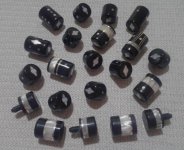
![IMG_9270[1].jpg](/data/attachments/293/293063-1594cd61bf26be8ab6fa3e0a56fb3a07.jpg?hash=FZTNYb8mvo)
